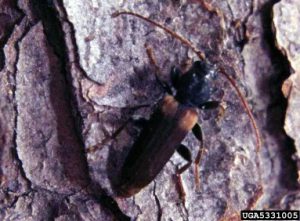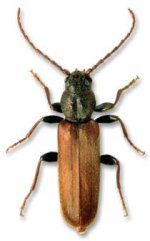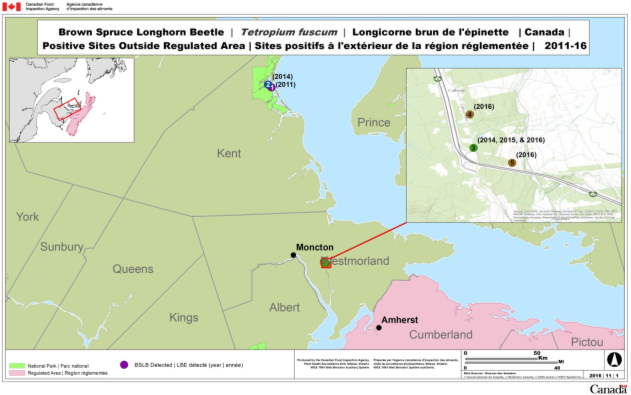Brown Spruce Longhorn Beetle (Tetropium fuscum)
French common name: Longicorne brun de l'épinettea

Photo credit: Jon Sweeney, Natural Resources Canada, Bugwood.org

Klaus Bolte, Natural Resources Canada, Canadian Forest Service
Order: Coleoptera
Family: Cerambycidae
The brown spruce longhorn beetle (Tetropium fuscum (Fabricius); BSLB) is native to northern and central Europe, western Siberia and Japan (CFIA, 2016). BSLB was likely introduced to North America on ships transporting wood packaging from Europe, and it was first discovered in 1999 in Point Pleasant Park, Halifax, Nova Scotia. The beetle is now found in the provinces of Nova Scotia and New Brunswick (CFIA, 2016).
The BSLB attack healthy white, black, red, and Norway spruce trees in Canada (CFIA, 2016), but prefers and performs better in stressed, dying and wind fallen spruce (Flaherty et al. 2011, 2013 a,b). Mature, larger diameter spruce trees (>10 cm dbh, diameter at breast height) are more commonly infested (Nelson et al. 2017). BSLB has the potential to spread throughout the range of spruce in Canada where it threatens spruce forests undergoing stress due to drought, defoliators, and wind damage, and could impact the wood products industry. Since 2000, the CFIA (Canadian Food Inspection Agency) has regulated the importation and movement of spruce wood products to limit the spread of BSLB from infested areas.
Physical Description
Eggs: White with a slight green tint in colour, oblong shape, 1 mm long, and are laid under bark scales of spruce trees.
Larvae: White with a tint of yellow and a red to brown head, measures between 1 mm (newly hatched) and 28 mm (mature).
Pupae: White in colour and measures 10–17 mm long and 3.8 mm wide
Adult: Brown to red in colour with a flat looking body, dark brown legs, antennae and head, reddish eyes, measures 0.8-1.8 cm.
Life Cycle
In spring, adult female BSLB lay eggs in the crevices of spruce tree bark (in a cluster of one to 10), and the eggs hatch 10-14 days after oviposition. The BSLB has six larval instars, and becomes sexually dimorphic in instars 5 and 6 (Flaherty et al., 2012). The larvae feed on the phloem (inner bark layer) to form irregular galleries and sawdust like excrement (Flaherty et al., 2012). Damage to this area of the tree impairs the transport of nutrients and sugars within the tree, and eventually leads to tree death. As a defense response, a spruce tree will produce resin, which can be seen dripping from an infested tree, and is commonly associated with BSLB infestation.
After approximately two months, the larvae are 1.5-2.5 cm long, and form a pupal cell either between the phloem and sapwood or 2-4 cm into the sapwood to overwinter (Cabi, 2017). Pupation occurs the following spring.
Adults make a 4-6mm diameter oval exit hole when they emerge. In Canada, the adult beetles emerge between late May and mid-August and live for approximately two weeks (CFIA, 2015a). These sexually mature adults do not feed and must locate a suitable host, mate, and lay eggs quickly upon emergence (Silk et al., 2007). In laboratory observations, adult BSLB can fly up to 20 km, but most flights observed in nature are less than 100 m (J. Sweeney, pers. comm.). Females lay an average of 80 eggs (Cabi, 2017). In Nova Scotia and Europe, the life cycle usually takes one year to complete but can take up to two years in cooler climates (CFIA, 2015a; CFIA, 2016). Larval development is significantly slower in healthy vs. stressed spruce trees (Flaherty et al., 2011).
To date, BSLB has been detected in Canada on spruce trees (Picea) exclusively, primarily on red spruce, but also on white, Norway, and black spruce. In Europe, BSLB mainly infests Norway spruce though there are rare reports of records in other conifer species (Juutinen, 1955; Ryan, 2013). Additionally, these beetles prefer spruce trees with a >10 cm dbh, and mature trees with a >30 cm dbh.
Signs and symptoms of BSLB include:
- L-shaped pupal chambers in the sapwood, called galleries, are detected when the infested tree wood is cut longitudinally. The galleries are usually packed with frass (insect excrement) and chewed wood.
- White resin dripping along the bole of the infested tree.
- Slightly oval exit holes 4-6 mm in diameter on the bark of the tree trunk with tunnels that extends 2-4 cm into the sapwood at an oblique angle.
- Thinning of the crown in trees infested for >3 years.
BSLB has been detected in at least nine counties of Nova Scotia and is considered well-established in much of Halifax and Hants counties. It has also been detected in Kouchibouguac Park and Calhoun, New Brunswick, but is only considered established at the latter site.
BSLB is tolerant of Canada’s cold climate and its distribution is not expected to be limited by low temperatures throughout the range of spruce.

A Ministerial Order, issued by the Canadian Food Inspection Agency (CFIA) in October 2000 and revised in 2015, limits spruce log and firewood movement out of the province of Nova Scotia and the municipality of Memramcook, New Brunswick (CFIA, 2015a).
A risk mitigation program, developed by the CFIA, allows forest industries within the regulated BSLB area in Nova Scotia to maintain a market access across Canada (CFIA, 2015b). This program requires proper manufacturing, treatment, containment and disposal of material to minimize the spread of BSLB out of regulated areas. Stakeholders and industries who meet program requirements can transport materials within the regulated area into non-regulated areas under CFIA Movement Certificates (CFIA, 2015b). This includes, but is not limited to, woodlots, nurseries, mills, and energy generating plants. However, all movement of materials from infested areas in Nova Scotia is prohibited during the high-risk period April 30th – September 15th (CFIA, 2015b).
The following CFIA plant protection directives relate to the BSLB:
- D-02-12 – Import requirements of non-manufactured wood and other non-propagative wood products, except solid wood packaging material, from all areas other than the continental United States
- D-98-08 – Entry Requirements for Wood Packaging Materials Produced in All Areas Other Than the Continental United States
Recent scientific studies have found the spread of BSLB in Nova Scotia to be relatively slow compared to that of other invasive species like the emerald ash borer (Rhainds et al., 2011). There are several possible reasons for the slow spread of BSLB, such as reduced mating success in low density populations near the fringes of its distribution (Rhainds et al., 2015), low colonization success in healthy trees (Flaherty et al., 2013b), and mortality from native parasitic wasps (Flaherty et al., 2011). Even given the relative slow spread of BSLB, impacts are possible.
In addition, many climate models predict greater frequency of extreme weather events in the future (e.g., wind storms and hurricanes) – which could in turn result in greater BSLB spread. Wind-blown or climate stressed spruce trees would be susceptible to colonization and mortality from BSLB.
To learn more about the risks associated with BSLB, access the Pest Risk Analysis (CCFM, 2014)
Economic impacts
The establishment and spread of BSLB could harm Canadian forest-industries, which are currently major contributors to the economy. The working forest provides billions of dollars in revenue to Canada. In 2016, the forest industry contributed to the Canadian economy by:
- Accounting for approximately 7% of Canada’s total exports; $34 billion into our economy and $1 billion revenue (2015) for provincial and territorial governments (NRCan, 2017)
- Supporting over 210,000 jobs across the country including over 9,500 for Indigenous people (NRCan, 2017)
Old-growth spruce forests are particularly at risk because BSLB tend to colonize older, larger diameter, slow-growing trees. In Canada the preferred host is red spruce, a valuable resource in pulp and lumber production (CFIA, 2012). The value of forest industry in Nova Scotia alone has been estimated at $2 billion, where 81% of total harvested wood from 2012–2015 was softwood lumber (including spruce trees) (Pinfold, 2016). Of the 4 million hectares of forest in Nova Scotia, 2 million hectares are of spruce (CCFM, 2014). However, due to regulation and control measures in Nova Scotia, no severe economic impacts due to BSLB have been reported (CCFM, 2014).
Ecological impacts
In areas where the BSLB is established, spruce trees that are of low vigor or stressed due to disturbance (e.g., wind storms, drought, defoliator outbreaks), are at risk of BSLB infestation. There is also evidence that BSLB may be displacing its the native congener, Tetropium cinnamopterum (Rhainds et al., 2011; Dearborn et al., 2016).
Spruce stands are widespread in Nova Scotia, and since some red spruce trees may not produce a large volume of seeds until 75 years of age or greater, loss of larger, older red spruce trees can have significant impacts on spruce stands (CFIA, 2012). Certain plant or animal species that are closely associated with spruce forests may also be at risk. For example, the gray jay stores berries, insects, and other foods in the nooks of coniferous trees, particularly black spruce trees (Strickland et al., 2011), as the resin allows for food preservation, especially during the winter. These caches allow the jays not only to survive the harsh winters, but successfully reproduce (Strickland et al., 2011).
Social impacts
The red spruce is the provincial tree of Nova Scotia, and it is an acknowledged symbol in Canadian forestry. This tree is now under attack from the BSLB.
Spruce trees, like many species, provide shade, increase aesthetic beauty, filter air and water pollutants, produce oxygen, provide hundreds of jobs in the forestry sector, and increase property values. Any widespread tree loss has the potential to impact tourism and recreation values, and community quality of life.
Generally, control of BSLB infestation will include mechanical means (e.g., felling and burning or chipping of infested trees to destroy the brood). Stem-injected insecticides are possible but this method is labour intensive and not economically feasible over large forested areas.
Prevent
Prevention of a BSLB infestation in a new area is the most effective way to reduce long-term impacts. To assist in preventing a BSLB infestation:
- Don’t move spruce firewood or other untreated spruce products, as BSLB larvae, pupae, or adults could be hidden inside
- Learn to identify a BSLB and its signs and symptoms
- Spread the word: educate family and friends of the potential threat
- Report any sightings
Regulatory controls, developed and enforced by the CFIA, restrict the movement spruce material outside of regulated areas.
Detect
Look for the visual signs and symptoms of BSLB infestation in trees, specifically, 4 mm elliptical exit holes in diameter and/or excess resin flow.
The CFIA conducts annual surveys using traps baited with pheromone (fuscumol) and spruce volatiles to look for BSLB. If BSLB is detected in a new area (i.e., outside of the regulated area) then additional actions will be taken.
The CFIA also runs detection surveys (using pheromone-baited traps) in areas considered to be high risk of BSLB introduction outside of the regulated area, including mature spruce forests, sawmills, pulpmills, campgrounds and ports (CFIA, 2017). Of the 306 survey sites in Quebec, New Brunswick, Prince Edward Island, Newfoundland and Labrador, three sites were positive for BSLB between 2011 and 2016 (CFIA, 2017). All three sites were in New Brunswick, for a total of six positively identified BSLB specimens (CFIA, 2017).
Respond & Control
Mechanical
Mechanical control can effectively eradicate early infestations of BSLB if the populations are detected early.
In 1999, shortly after the discovery of BSLB at Point Pleasant Park, Nova Scotia, a 20-km quarantine zone was put in place to prohibit movement of trees, logs and wood outside of the park (CFIA, 2012). Eradication was attempted by felling and burning spruce trees with signs of BSLB infestation (abundant resin flow on the trunk and 4-6 mm elliptical exit holes). More than 2500 spruce trees were felled in the greater Halifax area between 2000 and 2006. In 2007, the infested area had become too large and the program ended.
Trees are now only removed for research purposes or at isolated sites where BSLB has been detected well outside of the regulated area (CFIA, 2016).
Chemical and biological
National Resources Canada (NRCan) has researched BSLB suppression through aerial application of fuscumol in non-toxic, biodegradable flakes (NRCan, 2012). This synthetic sex-pheromone disrupts communication between mate seeking male and female beetles, and has reduced BSLB mating success by 50% in field trials (Sweeney et al., 2017). Suppression of BSLB by pheromone-mediated mating disruption gave greatest success in slowing the spread of BSLB if applied in low-density populations established outside of the generally infested area.
Pheromone-baited traps have also been adapted as “auto-dissemination devices” in which BSLB are attracted to a trap contaminated with a fungal pathogen, and are allowed to escape and spread the pathogen in the local population via mating (NRCan, 2012; Sweeney et al., 2013). Beetles infected with the fungal pathogen die sooner and females produce fewer eggs (NRCan, 2012). These pheromone-baited traps are known to have low exposure to non-target species, which minimizes the spread of fungal pathogens amongst non-targeted species (NRCan, 2012).
In Canada, operational application of the pheromone for suppression of BSLB by either mating disruption or auto-dissemination requires that they be registered as official pest control products with the Pest Management Regulatory Agency, and this has not been done. Reasons for this include high costs of registration, a relatively small market for their use, and in the case of the auto-disseminated pathogen, the need for additional efficacy data.
Fact Sheets

Add Your Heading Text Here





Add Your Heading Text Here





Add Your Heading Text Here
Best Management Practices





Lorem ipsum dolor sit amet, consectetur adipiscing elit. Ut elit tellus, luctus nec ullamcorper mattis, pulvinar dapibus leo.
Research
Research update on the brown spruce longhorn beetle, Tetropium fuscum (Fabr.)
Inspection Agency, was initiated in the spring of 2007 to address key issues of provincial
and forest industry stakeholders concerning the brown spruce longhorn beetle, Tetropium
fuscum (Fabr.)(Coleoptera: Cerambycidae). Tetropium fuscum is an invasive wood boring
beetle from Europe that has been established in Halifax, Nova Scotia since at least 1990.
The project is focused on the development of practical tools and knowledge for risk …
[PDF] The brown spruce longhorn beetle in Halifax: Pest status and preliminary results of research
Fabr.)(Coleoptera: Cerambycidae), a native· of Central Europe and parts of Asia, had
become established in Point Pleasant Park, Halifax, Nova Scotia, where it was killing red …
Update on survey and eradication of the brown spruce longhorn beetle, and summary of recent research
presented. Two North American species of parasitic wasps (one braconid, one
ichneumonid) that commonly parasitize the native Tetropium cinnamopterum have also …
Can the exotic brown spruce longhorn beetle, Tetropium fuscum, successfully colonize healthy trees in Canada?
Cerambycidae) was discovered emerging from red spruce, Picea rubens Sarg., in Halifax,
Nova Scotia in 1999. It is likely that T. fuscum has been established in the Halifax area for …
Current Research and Knowledge Gaps
Further Reading
The Invasive Species Centre aims to connect stakeholders. The following information below link to resources that have been created by external organizations.
